巧妙使用 Decorator 装饰 Typescript?
前言
原创文章汇总:github/Nealyang
正在着手写 THE LAST TIME 系列的 Typescript 篇,而Decorator 一直是我个人看来一个非常不错的切面方案。所谓的切面方案就是我们常说的切面编程 AOP。一种编程思想,简单直白的解释就是,一种在运行时,动态的将代码切入到类的指定方法、指定位置上的编程思想就是 AOP。AOP 和我们熟悉的 OOP 一样,只是一个编程范式,AOP 没有说什么规定要使用什么代码协议,必须要用什么方式去实现,这只是一个范式。而 Decorator 也就是AOP 的一种形式。
而本文重点不在于讨论编程范式,主要介绍 Typescript+Decorator 下图的一些知识讲解,其中包括最近笔者在写项目的一些应用。

介绍
什么是 Decorator
貌似在去年的时候在公众号:【全栈前端精选】中,有分享过关于 Decorator 的基本介绍:Decorator 从原理到实战,里面有对Decorator 非常详细的介绍。
本质上,它也就是个函数的语法糖。
Decorator 是 ES7 添加的新特性,当然,在 Typescript 很早就有了。早在此之前,就有提出与 Decorator 思想非常相近的设计模式:装饰者模式。

上图的WeaponAccessory就是一个Decorator,他们添加额外的功能到基类上。让其能够满足你的需求。

简单的理解 Decorator,可以认为它是一种包装,对 对象,方法,属性的包装。就像 Decorator 侠,一身盔甲,只是装饰,以满足需求,未改变是人类的本质。
为什么要使用 Decorator
为什么要使用 Decorator,其实就是介绍到 AOP 范式的最大特点了:非侵入式增强。
比如笔者正在写的一个页面容器,叫 PageContainer.tsx,基本功能包括滚动、autoCell、事件注入与解绑、placeHolder Container 的添加等基本功能。
class PageContainer extends Components{
xxx
}
这时候我正使用这个容器,想接入微信分享功能。或者错误兜底功能。但是使用这个容器的人非常多。分享不一定都是微信分享、错误兜底不一定都是张着我想要的样子。所以我必定要对容器进行改造和增强。
从功能点划分,这些的确属于容器的能力。所以在无侵入式的增强方案中,装饰者模式是一个非常好的选择。也就是话落到我们所说的 Decorator。(对于 React 或者 Rax,HOC 也是一种很好的方案,当然,其思想是一致的。)
+ @withError
+ @withWxShare
class PageContainer extends Components{
xxx
}
我们添加 Decorator,这样的做法,对原有代码毫无入侵性,这就是AOP的好处了,把和主业务无关的事情,放到代码外面去做。
关于 Typescript

JavaScript 毋庸置疑是一门非常好的语言,但是其也有很多的弊端,其中不乏是作者设计之处留下的一些 “bug”。当然,瑕不掩瑜~
话说回来,JavaScript 毕竟是一门弱类型语言,与强类型语言相比,其最大的编程陋习就是可能会造成我们类型思维的缺失(高级词汇,我从极客时间学到的)。而思维方式决定了编程习惯,编程习惯奠定了编程质量,工程质量划定了能力边界,而学习 Typescript,最重要的就是我们类型思维的重塑。
那么其实,Typescript 在我个人理解,并不能算是一个编程语言,它只是 JavaScript 的一层壳。当然,我们完全可以将它作为一门语言去学习。网上有很多推荐 or 不推荐 Typescript 之类的文章这里我们不做任何讨论,学与不学,用或不用,利与弊。各自拿捏~
再说说 typescript,其实对于 ts 相比大家已经不陌生了。更多关于 ts 入门文章和文档也是已经烂大街了。此文不去翻译或者搬运各种 api或者教程章节。只是总结罗列和解惑,笔者在学习 ts 过程中曾疑惑的地方。道不到的地方,欢迎大家评论区积极讨论。
首先推荐下各自 ts 的编译环境:typescriptlang.org
再推荐笔者收藏的两个网站:
- Typescript 中文网
- 深入理解 Typescript
- TypeScript Handbook
- TypeScript 精通指南
Typescript 中的 Decorator 签名
interface TypedPropertyDescriptor<T> {
enumerable?: boolean;
configurable?: boolean;
writable?: boolean;
value?: T;
get?: () => T;
set?: (value: T) => void;
}
declare type ClassDecorator = <TFunction extends Function>(target: TFunction) => TFunction | void;
declare type PropertyDecorator = (target: Object, propertyKey: string | symbol) => void;
declare type MethodDecorator = <T>(target: Object, propertyKey: string | symbol, descriptor: TypedPropertyDescriptor<T>) => TypedPropertyDescriptor<T> | void;
declare type ParameterDecorator = (target: Object, propertyKey: string | symbol, parameterIndex: number) => void;
如上是 ClassDecorator、PropertyDecorator以及 MethodDecorator 的三个类型签名。
基本配置
由于 Decorator 在 Typescript 中还是一项实验性的给予支持,所以在 ts 的配置配置文件中,我们指明编译器对 Decorator 的支持。
在命令行或tsconfig.json里启用experimentalDecorators编译器选项:
- 命令行:
tsc --target ES5 --experimentalDecorators
- tsconfig.json
{
"compilerOptions": {
"target": "ES5",
"experimentalDecorators": true
}
}
类型
在 Typescript 中,Decorator 可以修饰五种语句:类、属性、方法、访问器和方法参数。
class definitions
类装饰器应用于构造函数之上,会在运行时当作函数被调用,类的构造函数作为其唯一的参数。
注意,在 Typescript 中的class 关键字只是 JavaScript 构造函数的一个语法糖。由于类装饰器的参数是一个构造函数,其也应该返回一个构造函数。
我们先看一下官网的例子:
function classDecorator<T extends { new (...args: any[]): {} }>(
constructor: T
) {
return class extends constructor {
newProperty = "new property";
hello = "override";
};
}
@classDecorator
class Greeter {
property = "property";
hello: string;
constructor(m: string) {
this.hello = m;
}
}
const greeter: Greeter = new Greeter("world");
console.log({ greeter }, greeter.hello);

{ new (...args: any[]): {} }表示一个构造函数,为了看起来清晰一些,我们也可以将其声明到外面:
/**
*构造函数类型
*
* @export
* @interface Constructable
*/
export interface IConstructable {
new (...args:any[]):any
}
properties
属性装饰器有两个参数:
- 对于静态成员来说是类的构造函数,对于实例成员是类的原型对象。
- 成员的key。
descriptor不会做为参数传入属性装饰器,这与TypeScript是如何初始化属性装饰器的有关。因为目前没有办法在定义一个原型对象的成员时描述一个实例属性,并且没办法监视或修改一个属性的初始化方法。返回值也会被忽略。因此,属性描述符只能用来监视类中是否声明了某个名字的属性。
function setDefaultValue(target: Object, propertyName: string) {
target[propertyName] = "Nealayng";
}
class Person {
@setDefaultValue
name: string;
}
console.log(new Person().name); // 输出: Nealayng
将上面的代码修改一下,我们给静态成员添加一个 Decorator
function setDefaultValue(target: Object, propertyName: string) {
console.log(target === Person);
target[propertyName] = "Nealayng";
}
class Person {
@setDefaultValue
static displayName = 'PersonClass'
name: string;
constructor(name:string){
this.name = name;
}
}
console.log(Person.prototype);
console.log(new Person('全栈前端精选').name); // 输出: 全栈前端精选
console.log(Person.displayName); // 输出: Nealayng

以此可以验证,上面我们说的:Decorator 的第一个参数,对于静态成员来说是类的构造函数,对于实例成员是类的原型对象
methods
方法装饰器表达式会在运行时当作函数被调用,传入下列3个参数:
- 对于静态成员来说是类的构造函数,对于实例成员是类的原型对象。
- 成员的名字。
- 成员的属性描述符
descriptor。
注意: 如果代码输出目标版本小于ES5,descriptor将会是undefined。
function log(
target: Object,
propertyName: string,
descriptor: TypedPropertyDescriptor<(...args: any[]) => any>
) {
const method = descriptor.value;
descriptor.value = function(...args: any[]) {
// 将参数转为字符串
const params: string = args.map(a => JSON.stringify(a)).join();
const result = method!.apply(this, args);
// 将结果转为字符串
const resultString: string = JSON.stringify(result);
console.log(`Call:${propertyName}(${params}) => ${resultString}`);
return result;
};
}
class Author {
constructor(private firstName: string, private lastName: string) {}
@log
say(message: string): string {
return `${message} by: ${this.lastName}${this.firstName}`;
}
}
const author:Author = new Author('Yang','Neal');
author.say('《全站前端精选》');//Call:say("全站前端精选") => "全站前端精选 by: NealYang"
上述的代码比较简单,也就不做过多解释了。其中需要注意的是属性描述符 descriptor 的类型和许多文章写的类型有些不同:propertyDescriptor: PropertyDescriptor。

从官方的声明文件可以看出,descriptor 设置为TypedPropertyDescriptor加上泛型约束感觉更加的严谨一些。

当然,官网也是直接声明为类型PropertyDescriptor的。这个,仁者见仁。
accessors
访问器,不过是类声明中属性的读取访问器和写入访问器。访问器装饰器表达式会在运行时当作函数被调用,传入下列3个参数:
- 对于静态成员来说是类的构造函数,对于实例成员是类的原型对象。
- 成员的名字。
- 成员的属性描述符。
如果代码输出目标版本小于ES5,Property Descriptor将会是undefined。同时 TypeScript 不允许同时装饰一个成员的get和set访问器
function Enumerable(
target: any,
propertyKey: string,
descriptor: PropertyDescriptor
) {
//make the method enumerable
descriptor.enumerable = true;
}
class Person {
_name: string;
constructor(name: string) {
this._name = name;
}
@Enumerable
get name() {
return this._name;
}
}
console.log("-- creating instance --");
let person = new Person("Diana");
console.log("-- looping --");
for (let key in person) {
console.log(key + " = " + person[key]);
}

如果上面 get 不添加Enumerable的话,那么 for in 只能出来_name _name = Diana
parameters
参数装饰器表达式会在运行时当作函数被调用,传入下列3个参数:
- 对于静态成员来说是类的构造函数,对于实例成员是类的原型对象。
- 成员的名字。
- 参数在函数参数列表中的索引。
参数装饰器只能用来监视一个方法的参数是否被传入。
在下面的示例中,我们将使用参数装饰器@notNull来注册目标参数以进行非空验证,但是由于仅在加载期间调用此装饰器(而不是在调用方法时),因此我们还需要方法装饰器@validate,它将拦截方法调用并执行所需的验证。
function notNull(target: any, propertyKey: string, parameterIndex: number) {
console.log("param decorator notNull function invoked ");
Validator.registerNotNull(target, propertyKey, parameterIndex);
}
function validate(target: any, propertyKey: string, descriptor: PropertyDescriptor) {
console.log("method decorator validate function invoked ");
let originalMethod = descriptor.value;
//wrapping the original method
descriptor.value = function (...args: any[]) {//wrapper function
if (!Validator.performValidation(target, propertyKey, args)) {
console.log("validation failed, method call aborted: " + propertyKey);
return;
}
let result = originalMethod.apply(this, args);
return result;
}
}
class Validator {
private static notNullValidatorMap: Map<any, Map<string, number[]>> = new Map();
//todo add more validator maps
static registerNotNull(target: any, methodName: string, paramIndex: number): void {
let paramMap: Map<string, number[]> = this.notNullValidatorMap.get(target);
if (!paramMap) {
paramMap = new Map();
this.notNullValidatorMap.set(target, paramMap);
}
let paramIndexes: number[] = paramMap.get(methodName);
if (!paramIndexes) {
paramIndexes = [];
paramMap.set(methodName, paramIndexes);
}
paramIndexes.push(paramIndex);
}
static performValidation(target: any, methodName: string, paramValues: any[]): boolean {
let notNullMethodMap: Map<string, number[]> = this.notNullValidatorMap.get(target);
if (!notNullMethodMap) {
return true;
}
let paramIndexes: number[] = notNullMethodMap.get(methodName);
if (!paramIndexes) {
return true;
}
let hasErrors: boolean = false;
for (const [index, paramValue] of paramValues.entries()) {
if (paramIndexes.indexOf(index) != -1) {
if (!paramValue) {
console.error("method param at index " + index + " cannot be null");
hasErrors = true;
}
}
}
return !hasErrors;
}
}
class Task {
@validate
run(@notNull name: string): void {
console.log("running task, name: " + name);
}
}
console.log("-- creating instance --");
let task: Task = new Task();
console.log("-- calling Task#run(null) --");
task.run(null);
console.log("----------------");
console.log("-- calling Task#run('test') --");
task.run("test");
对应的输出位:
param decorator notNull function invoked
method decorator validate function invoked
-- creating instance --
-- calling Task#run(null) --
method param at index 0 cannot be null
validation failed, method call aborted: run
----------------
-- calling Task#run('test') --
running task, name: test
@validate装饰器把run方法包裹在一个函数里在调用原先的函数前验证函数参数.
装饰器工厂
装饰器工厂真的也就是一个噱头(造名词)而已,其实也是工厂的概念哈,毕竟官方也是这么号称的。在实际项目开发中,我们使用的也还是挺多的
**装饰器工厂就是一个简单的函数,它返回一个表达式,以供装饰器在运行时调用。**其实说白了,就是一个函数 return 一个 Decorator。非常像 JavaScript 函数柯里化,个人称之为“函数式Decorator”~

import { logClass } from './class-decorator';
import { logMethod } from './method-decorator';
import { logProperty } from './property-decorator';
import { logParameter } from './parameter-decorator';
// 装饰器工厂,根据传入的参数调用相应的装饰器
export function log(...args) {
switch (args.length) {
case 3: // 可能是方法装饰器或参数装饰器
// 如果第三个参数是数字,那么它是索引,所以这是参数装饰器
if typeof args[2] === "number") {
return logParameter.apply(this, args);
}
return logMethod.apply(this, args);
case 2: // 属性装饰器
return logProperty.apply(this, args);
case 1: // 类装饰器
return logClass.apply(this, args);
default: // 参数数目不合法
throw new Error('Not a valid decorator');
}
}
@log
class Employee {
@log
private name: string;
constructor(name: string) {
this.name = name;
}
@log
greet(@log message: string): string {
return `${this.name} says: ${message}`;
}
}
加载顺序
一个类中,不同位置声明的装饰器,按照以下规定的顺序应用:
- 有多个参数装饰器(
parameterDecorator)时,从最后一个参数依次向前执行 - 方法(
methodDecorator)和方法参数装饰器(parameterDecorator)中,参数装饰器先执行 - 类装饰器(
classDecorator)总是最后执行。 - 方法(
methodDecorator)和属性装饰器(propertyDecorator),谁在前面谁先执行。因为参数属于方法一部分,所以参数会一直紧紧挨着方法执行。
function ClassDecorator() {
return function (target) {
console.log("I am class decorator");
}
}
function MethodDecorator() {
return function (target, methodName: string, descriptor: PropertyDescriptor) {
console.log("I am method decorator");
}
}
function Param1Decorator() {
return function (target, methodName: string, paramIndex: number) {
console.log("I am parameter1 decorator");
}
}
function Param2Decorator() {
return function (target, methodName: string, paramIndex: number) {
console.log("I am parameter2 decorator");
}
}
function PropertyDecorator() {
return function (target, propertyName: string) {
console.log("I am property decorator");
}
}
@ClassDecorator()
class Hello {
@PropertyDecorator()
greeting: string;
@MethodDecorator()
greet( @Param1Decorator() p1: string, @Param2Decorator() p2: string) { }
}
输出为:
I am parameter2 decorator
I am parameter1 decorator
I am method decorator
I am property decorator
I am class decorator
实战
由于是业务代码,与技术无关琐碎,只截取部分代码示意,非 Decorator 代码,以截图形式
这应该也是整理这篇文章最开始的原因了。直接说说项目(rax1.0+Decorator)吧。
需求很简单,就是是编写一个页面的容器。
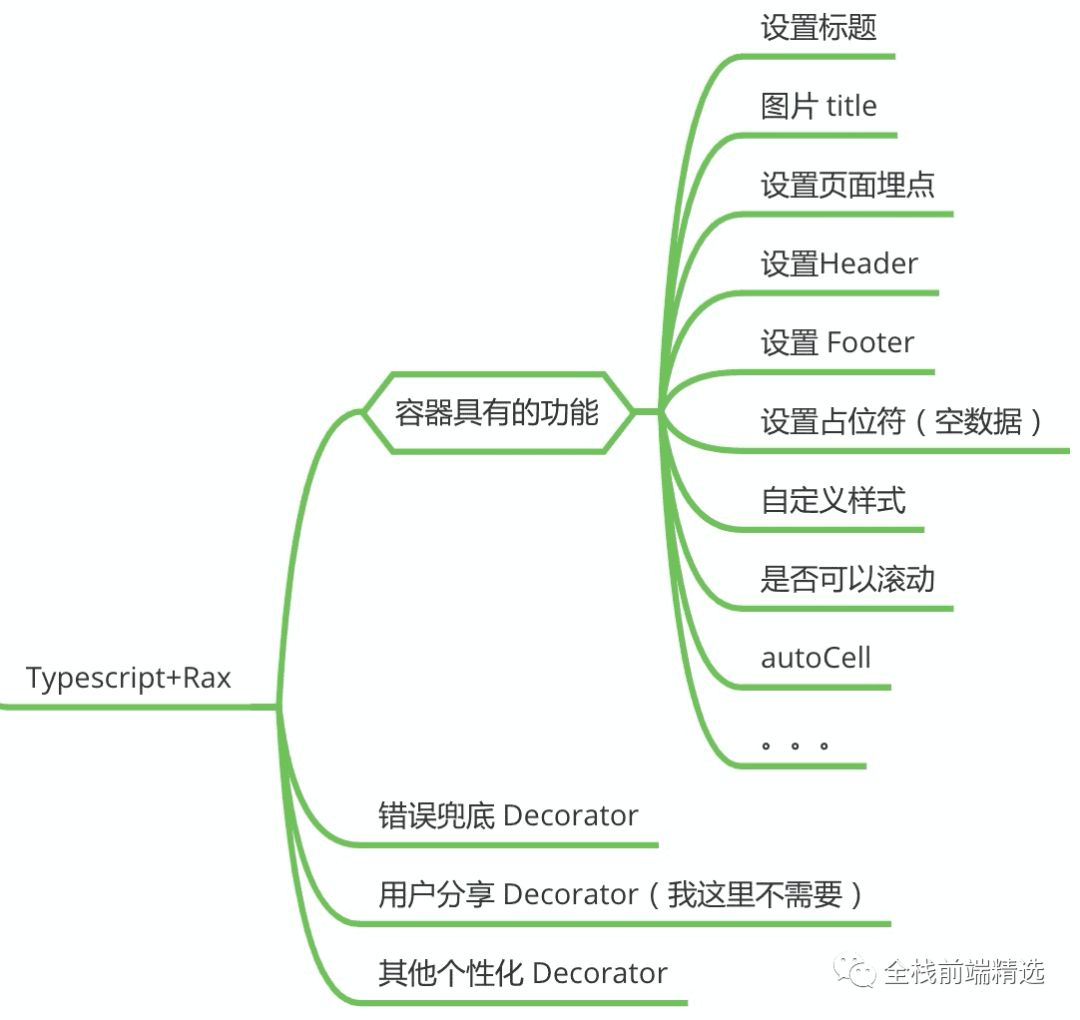
部分项目结构:
pm-detail
├─ constants
│ └─ index.ts //常量
├─ index.css
├─ index.tsx // 入口文件
└─ modules // 模块
└─ page-container // 容器组件
├─ base //容器基础组件
├─ decorator // 装饰器
├─ index.tsx
├─ lib // 工具
└─ style.ts
重点看下如下几个文件
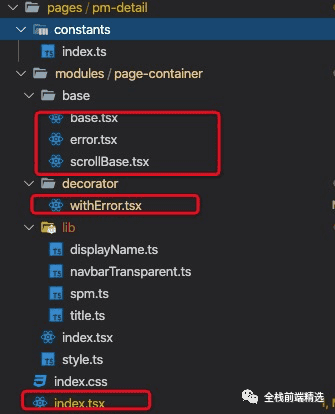
- base.tsx
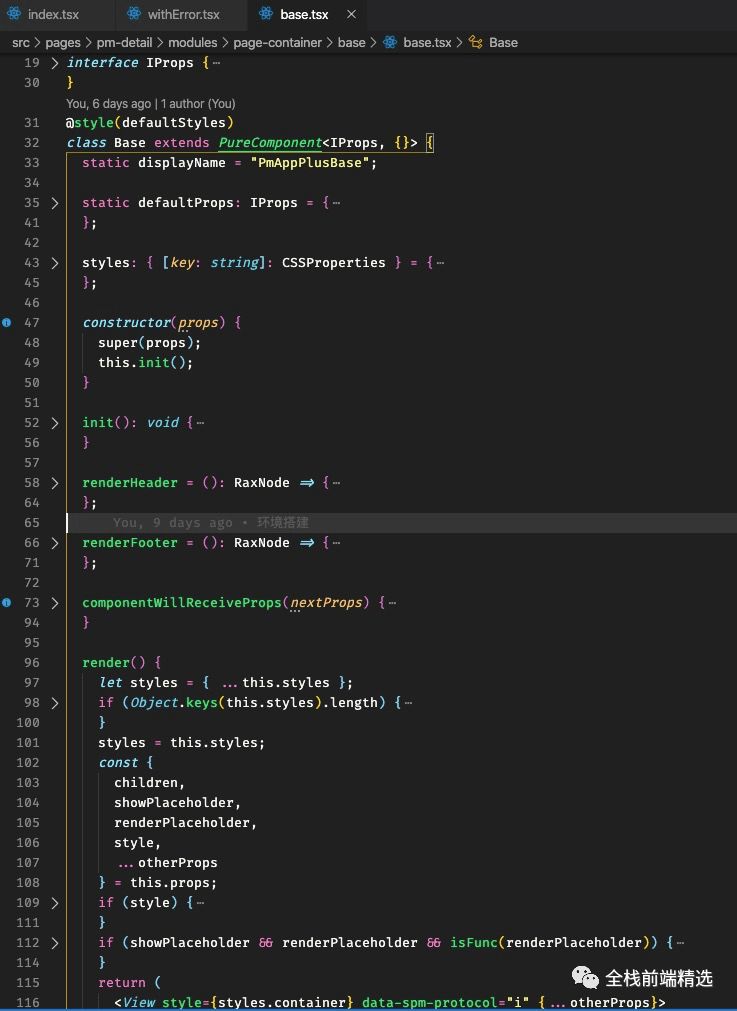
其实是基础功能的封装
在此基础上,我们需要个能滚动的容器
- scrollbase.tsx

也是基于 Base.tsx 基础上,封装一些滚动容器具有的功能
- style decorator
import is from './util/is';
import map from './util/map';
const isObject = is(Object);
const isFunction = is(Function);
class Style {
static factory = (...args) => new Style(...args);
analyze(styles, props, state) {
return map(v => {
if (isFunction(v)) {
const r = v.call(this.component, props, state);
return isObject(r) ? this.analyze(r, props, state) : r;
}
if (isObject(v)) return this.analyze(v, props, state);
return v;
})(styles);
}
generateStyles(props, state) {
const { styles: customStyles } = props;
const mergedStyles = this.analyze(this.defaultStyles, props, state);
if (customStyles) {
Object.keys(customStyles).forEach(key => {
if (mergedStyles[key]) {
if (isObject(mergedStyles[key])) {
Object.assign(mergedStyles[key], customStyles[key]);
} else {
mergedStyles[key] = customStyles[key];
}
} else {
mergedStyles[key] = customStyles[key];
}
});
}
return {
styles: mergedStyles,
};
}
constructor(defaultStyles = {}, { vary = true } = {}) {
const manager = this;
this.defaultStyles = defaultStyles;
return BaseComponent => {
const componentWillMount = BaseComponent.prototype.componentWillMount;
const componentWillUpdate = BaseComponent.prototype.componentWillUpdate;
BaseComponent.prototype.componentWillMount = function() {
manager.component = this;
Object.assign(this, manager.generateStyles(this.props, this.state));
return componentWillMount && componentWillMount.apply(this, arguments);
};
if (vary) {
BaseComponent.prototype.componentWillUpdate = function(nextProps, nextState) {
Object.assign(this, manager.generateStyles(nextProps, nextState));
return componentWillUpdate && componentWillUpdate.apply(this, arguments);
};
}
return BaseComponent;
};
}
}
export default Style.factory;
然后我们需要一个错误的兜底功能,但是这个本身应该不属于容器的功能。所以我们封装一个 errorDecorator
- withError.txs
function withError<T extends IConstructable>(Wrapped: T) {
const willReceiveProps = Wrapped.prototype.componentWillReceiveProps;
const didMount = Wrapped.prototype.componentDidMount;
const willUnmount = Wrapped.prototype.componentWillUnmount;
return class extends Wrapped {
static displayName: string = `WithError${getDisplayName(Wrapped)}·`;
static defaultProps: IProps = {
isOffline: false,
isError: false,
errorRefresh: () => {
window.location.reload(true);
}
};
private state: StateType;
private eventNamespace: string = "";
constructor(...args: any[]) {
super(...args);
const { isOffline, isError, errorRefresh, tabPanelIndex } = this.props;
this.state = {
isOffline,
isError,
errorRefresh
};
if (tabPanelIndex > -1) {
this.eventNamespace = `.${tabPanelIndex}`;
}
}
triggerErrorHandler = e => {...};
componentWillReceiveProps(...args) {
if (willReceiveProps) {
willReceiveProps.apply(this, args);
}
const [nextProps] = args;
const { isOffline, isError, errorRefresh } = nextProps;
this.setState({
isOffline,
isError,
errorRefresh
});
}
componentDidMount(...args) {
if (didMount) {
didMount.apply(this, args);
}
const { eventNamespace } = this;
emitter.on(
EVENTS.TRIGGER_ERROR + eventNamespace,
this.triggerErrorHandler
);
}
componentWillUnmount(...args) {
if (willUnmount) {
willUnmount.apply(this, args);
}
const { eventNamespace } = this;
emitter.off(
EVENTS.TRIGGER_ERROR + eventNamespace,
this.triggerErrorHandler
);
}
render() {
const { isOffline, isError, errorRefresh } = this.state;
if (isOffline || isError) {
let errorType = "system";
if (isOffline) {
errorType = "offline";
}
return <Error errorType={errorType} refresh={errorRefresh} />;
}
return super.render();
}
};
}
然后我们进行整合导出
import { createElement, PureComponent, RaxNode } from 'rax';
import ScrollBase from "./base/scrollBase";
import withError from "./decorator/withError";
interface IScrollContainerProps {
spmA:string;
spmB:string;
renderHeader?:()=>RaxNode;
renderFooter?:()=>RaxNode;
[key:string]:any;
}
@withError
class ScrollContainer extends PureComponent<IScrollContainerProps,{}> {
render() {
return <ScrollBase {...this.props} />;
}
}
export default ScrollContainer;
使用如下:
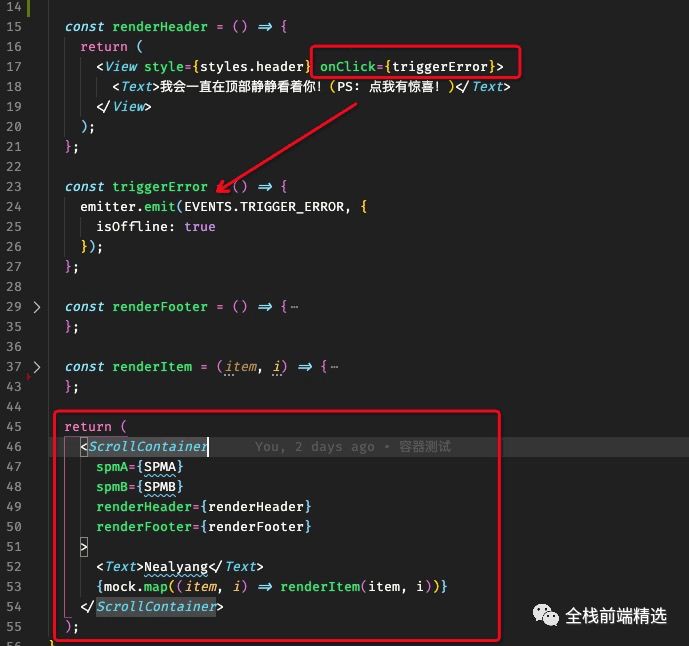
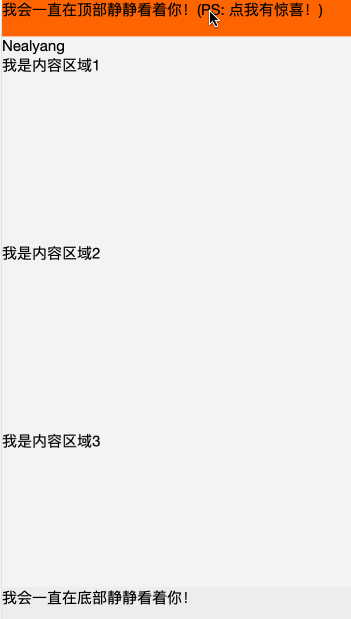
思维导图
最后附一张,本文思维导图。
公众号回复:【xmind1】 获取思维导图源文件
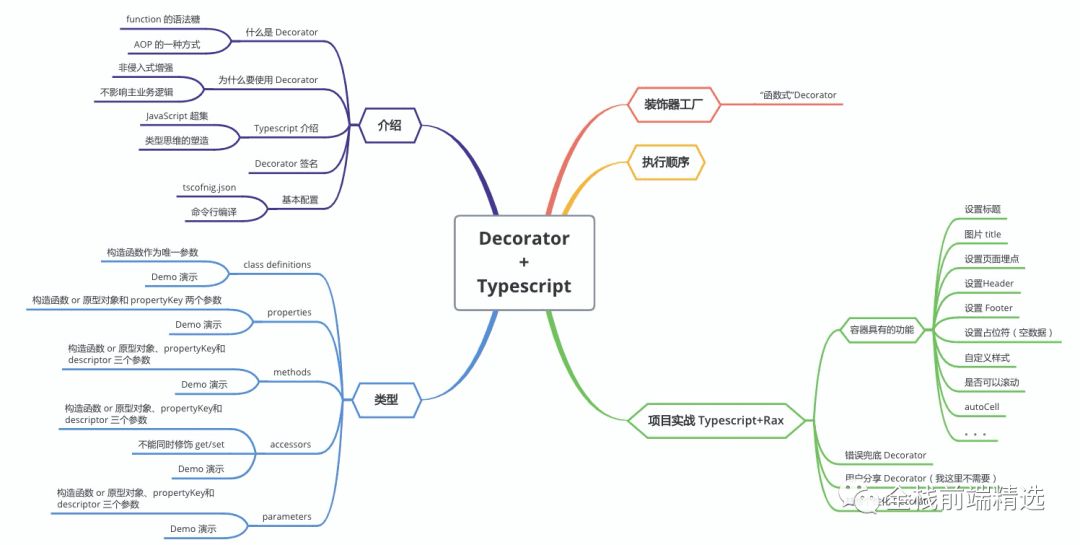
参考文献
- TypeScript装饰器(decorators)
- 文档
- TypeScript - Class Decorators
完
❤️ 看 完 三 件 事
如 果 你 觉 得 这 篇 内 容 对 你 挺 有 启 发 , 我 想 邀 请 你 帮 我 三 个 小 忙 :
- 点 赞 , 让 更 多 的 人 也 能 看 到 这 篇 内 容 ( 收 藏 不 点 赞 , 都 是 耍 流 氓 ) 。
- 关 注 公 众 号 「 入 坑 互 联 网 」 , 不 定 期 分 享 原 创 知 识 。
- 也 看 看 其 它 文 章
超 实 用 面 试 题 - - 真 实 面 试 经 验 归 纳 ! ! !
- E N D -
结 伴 同 行 前 端 路
![]()
